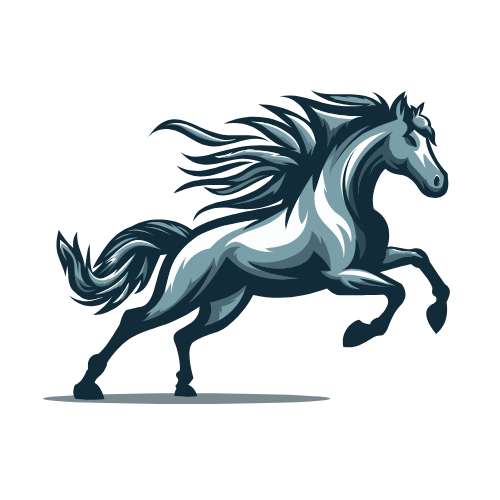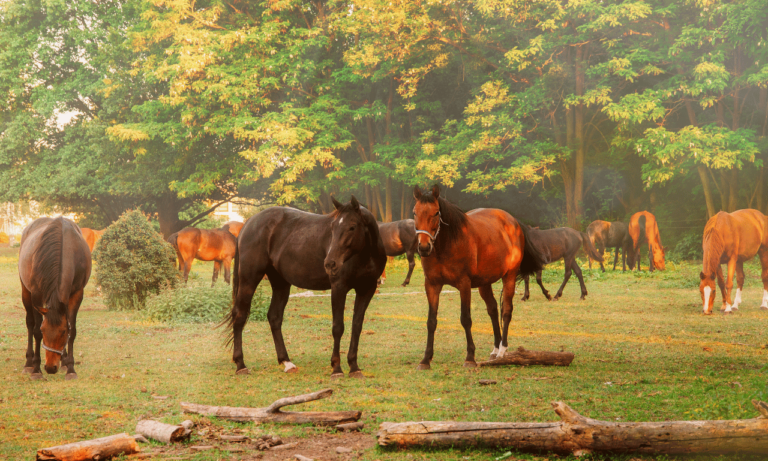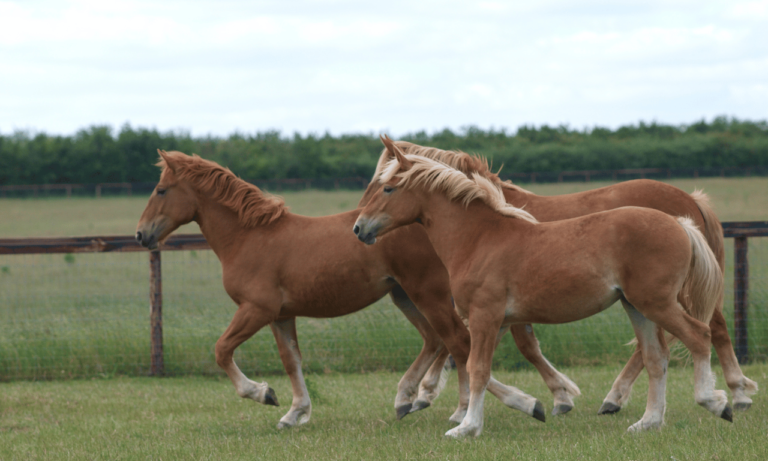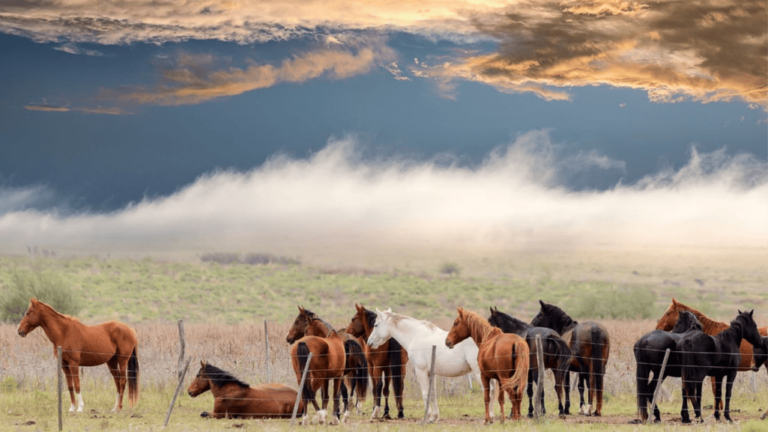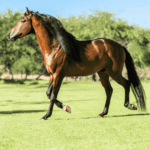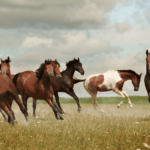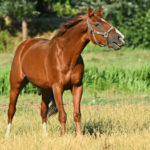The Arabian horse is known for its unique look and lasting energy. It comes from the Arabian Peninsula and is one of the oldest horse breeds. They have Arabian horse traits like arched necks, fine heads, and high tails, showing energy and nobility.
These horses are not just beautiful; they are smart and lively. This makes them great for many equestrian activities. When we talk about Arabian horse care, it’s clear why they are loved by so many. Their Arabian horse characteristics show their amazing athleticism and their deep bond with humans.
Key Takeaways
- The United States has the most Arabian horses, making it a key place for fans and breeders.
- There are over 700 racing events for Arabian horses every year, showing their importance in equestrian sports.
- With more than 400 shows in the U.S. and Canada, Arabian horses are popular in competitions.
- Arabian horses often win endurance events, proving their strength and lung power.
- Bedouins have bred Arabian horses for centuries, keeping the breed pure and showing their dedication.
Exploring the Rich History of Arabian Horses
The history of Arabian horses is as captivating as the horses themselves. They come from the Arabian Peninsula’s deserts. The Arabian horse origin is tied to the Bedouins, who saw these horses as more than just animals. They were treasures of the nomadic tribes.
The tribes played a big role in creating the purebred Arabian. They bred them for traits that helped them survive in harsh desert conditions. These traits made the horses incredibly resilient and versatile.
One might ask how Arabian horse history relates to their physical traits and abilities. Arabians have a unique head shape, high tail, and amazing endurance. These traits have been preserved for nearly 5000 years.
The purebred Arabian has not only endured but thrived. They have influenced many modern horse breeds. Their history is a testament to their strength and beauty.
| Characteristic | Detail |
|---|---|
| Origin Year | c. 5000 B.C. |
| Typical Traits | High tail carriage, small refined head |
| Preferred Environment | Harsh desert conditions |
| Breeding Influence | Thoroughbred, Morgan, American Quarter Horse |
| Notable Programs | MSU Arabian Horse Teaching & Research Program |
The Bedouins bred these horses with care. They aimed to improve their physical traits, endurance, and intelligence. These qualities made them excellent war mounts and companions.
The bond between the Bedouins and their horses is strong. It shows the respect and need they had for each other. This bond has made the Arabian horse history important in both equestrian and human culture.
Today, the purebred Arabian is known worldwide. Their lineage has helped create and improve many modern horse breeds. Their history and popularity show their importance in human culture and history.
As we delve into Arabian horse history, we see their endurance, nobility, and influence. Their story is a testament to their impact on human history. It shows how Arabian horses have shaped our culture.
Defining Characteristics of the Arabian Horse
The Arabian horse is one of the oldest horse breeds. It has unique features that make it stand out. These qualities add to its elegance and endurance.
Anatomy of an Icon: The Distinguished Physique
Arabian horses have a finely chiseled head and large eyes. They are medium-sized, measuring between 14.1 and 15.1 hands. Their skeletal structure is different, with 23 vertebrae instead of the usual 24.
This makes their back short and strong. It also helps them move efficiently, perfect for long distances.
Unmistakable Pride: The Floating Trot and High Tail Carriage
The Arabian horse has a unique way of moving. They have a high tail and a “floating trot” that shows off their spirit. These movements highlight their agility and long history.
They are known for their proud appearance in shows and parades. This reflects their historical prestige.
Arabian horses are about 15 hands tall and weigh 800 to 1,000 pounds. Their size and build give them great stamina. They are also very intelligent and adaptable.
| Feature | Details |
|---|---|
| Origin | Arabian Peninsula, around 5000 B.C. |
| Average Lifespan | 25-30 years, often exceeding 30 |
| Height | 14.1 to 15.1 hands (57 to 61 inches, 145 to 155 cm) |
| Weight | 800 to 1,000 pounds (360 to 450 kg) |
| Coat Colors | Primarily bay, black, chestnut, gray; infrequent roan |
| Unique Skeletal Feature | 23 vertebrae, typically one fewer than other breeds |
| Temperament | Intelligent, quick learners, friendly, loyal |
The Arabian horse is admired worldwide for its beauty and strength. It is a living legend in the world of horses.
Arabian Horse Temperament and Intelligence
Exploring Arabian horse facts reveals their unique Arabian temperament. These horses are known for their intelligence and friendly nature. They are easy to train and have a gentle heart.
Arabian horses are alert and love to learn. This makes them quick learners. They are popular among trainers and fans for their reliability and charm.
| Characteristic | Details |
|---|---|
| Weight Range | 800 to 1,000 pounds |
| Height | 14 to 16 hands (56 to 64 inches) |
| Lifespan | 25 – 30 years |
| Typical Coat Colors | Bay, Gray, Chestnut, Black, Roan |
| Genetic Disorders | Severe combined immunodeficiency, Lavender foal syndrome, Cerebellar abiotrophy |
| Average Price | $5,000 to $20,000 |
| Notable Traits | Intelligence, Sociability, Trainability |
| Adaptability | Highly adaptable to various environments |
The intelligence of Arabian horses makes training easier. It also ensures a safe experience for riders. They excel in many activities, from trails to shows, and build strong bonds with their handlers.
The Arabian Horse Legacy: Influence on Other Breeds
The Arabian horse has greatly influenced horses worldwide. Its genetics are at the heart of many breeds today. This mix of old and new has made horses stronger and more enduring.
The Arabian’s Role in Developing Thoroughbreds and Other Breeds
The Arabian has shaped the Thoroughbred, making them faster and more enduring. It has also helped create breeds like the Orloff Trotter in Russia and the Percheron in France. In the U.S., it has influenced the Morgan breed, showing the Arabian’s versatility.
Global Dominance: Arabian Bloodlines in Modern Equine Breeding
Today, Arabian breeding is more than keeping old genetics alive. It’s a key factor in making horses better worldwide. North America has more registered Arabians than anywhere else, showing their popularity.
Arabian bloodlines improve speed, efficiency, and stamina. They’ve made a big difference in horse breeds globally. For example, Arabian horses in South Africa do well in different settings, from racing to shows.
This legacy is backed by history and today’s champions. Horses like Emigrantka, born in 1985, have left a mark. Her offspring, like Edeon and El Mundo, have won in Europe and North America, spreading the Arabian’s influence.
| Horse | Contribution | Achievements | Descendants |
|---|---|---|---|
| Emigrantka | Breeding & Show Competitions | 12 foals over 13 years | 5 fillies, 7 colts (diverse winners) |
| Edeon | Progeny Success | Polish National Reserve Champion Colt | Exported to the UK |
| El Mundo | International Recognition | Champion in the US, Canada, and Scottsdale | Influential in North American breeding |
The quest for excellence in Arabian breeding continues. It’s shaping the future of horses worldwide.
Caring for Your Arabian Horse Nutrition and Diet
Keeping Arabian horses healthy for over 25 years starts with good care and nutrition. It’s key to have a special diet plan for them. This is especially true for their long lifespan and specific needs.
Balanced Feeding: Tailoring Your Arabian’s Nutritional Plan
Understanding Arabian horse feeding is vital for their health. They need high-quality hay, about 1% to 1.5% of their body weight each day. They also need plenty of water, five to ten gallons a day, more in hot weather or when they’re active.
Grains like oats, corn, and barley are also important. They depend on the horse’s age, work, and metabolism. Older horses need special care to manage weight and health issues like dental problems and digestive issues.
Supplementing the Diet: When and How to Introduce New Foods
Adding new foods to your Arabian’s diet should be done slowly. This helps avoid stomach problems. Start by introducing new foods over several days to watch how they react.
For older horses or those with health issues, like Cushing’s disease or diabetes, talk to a vet. They can help adjust the diet. Recent studies show the importance of careful feeding to balance hormones and meet nutritional needs.
In summary, caring for Arabian horses means a diet tailored to their needs at every stage of life. Working with equine nutrition experts and vets is key to keeping them healthy and happy.
Understanding Arabian Horse Behavior and Social Traits
Exploring the Arabian horse behavior and Arabian horse social traits shows their unique character. They are not just beautiful; they have a special Arabian horse personality. This makes them great for helping people emotionally and growing personally.
Arabian horses can really connect with human feelings. For example, Zaki, a grey Arabian gelding, is very sensitive and helps people heal emotionally. Ara Markash, a chestnut Arabian gelding, is 31 and clients see him as their best friend. He helps them understand themselves better.
Arabian horses also show human-like social traits. They form friendships and have a hierarchy in their groups, just like people do. This is seen in therapy, where horses help people grow. They help people feel and deal with their emotions, leading to change.
They are very sensitive, acting as mirrors to our emotions. This non-verbal way of connecting can reach deeper than usual therapy. It helps find and heal deep emotional wounds.
Here’s a closer look at their social interactions and what a study found:
| Study Summary on Arabian Mare Behavior | |
|---|---|
| Number of Mares: | 12 purebred, 9 pregnant, 3 barren |
| Paddock Size: | 3000-3500 m2 per mare |
| Hierarchy: | Determined by approach order to food crib |
| Experimental Setup: | Social separations in groups of dominant, mixed, and submissive mares |
| Variables Monitored: | Behavior rates, locomotor, and cardiac activity |
| Significance: | Insight into social structure and stress responses |
Using these Arabian horse social traits in therapy helps people grow and heal emotionally. It shows how Arabian horses play a big role in helping humans.
Competitive Edge: The Arabian Horse in Equestrian Sports
Arabian horses are known for their endurance, agility, and athleticism. They excel in endurance rides and competitive trails. Their strength and stamina come from selective breeding.
But they’re not just for endurance. They also shine in dressage, racing, and Arabian horse shows. This shows their versatility and skill.
Endurance and Agility: Why Arabians Excel on Track and Trail
Arabian horses lead in endurance competitions. Their stamina is due to their unique genetic makeup. This includes dense bones and strong backs, allowing them to carry weight over long distances.
Research has found specific chromosomes in Arabians that boost endurance. These traits help them perform well in challenging terrains and long events. This makes them a favorite among endurance riders.
From Dressage to Racing: The Versatile Athleticism of Arabians
Arabian horses also excel in dressage and racing. Their agile footwork and graceful movements are perfect for these sports. They can do complex maneuvers with balance and precision.
In racing, their consistent times show their skill. The Arabian horse show calendar is full of events that highlight their versatility. This draws fans who love their athletic abilities in different disciplines.
Knowing the Arabian horse show calendar helps fans and competitors. It lets them plan for shows and training sessions. The calendar shows national and international competitions. This helps participants plan and make the most of their horses’ abilities.
Arabian horses are not just athletes. They are also beloved companions in equestrian circles. Their traits make them remarkable in both competitive and recreational settings.
Arabian Horse Grooming and Regular Health Care Routines
Keeping Arabian horses healthy and beautiful is a big job. It includes grooming, health checks, and the right food. These horses are not just beautiful; they need careful care to stay that way.
Every day, Arabian horses get a grooming routine that makes their coat shine. Brushes like curry combs remove dirt and spread natural oils. This keeps their coat healthy and shiny.
Special care is needed for their long mane and tail. Detanglers and the right tools help keep them flowing and untangled. This is important for their look in shows.
| Aspect | Detail |
|---|---|
| Hoof Care | Trimming and shoeing every two months to prevent issues like thrush, chips, and cracks. |
| Skin Care | Regular checks for sarcoids and melanomas, with treatments as necessary to maintain skin health. |
| Health Check-Ups | Essential vaccinations, dental exams, and regular check-ups to monitor for conditions like arthritis or tendonitis. |
| Nutrition | High-quality hay and grains, adjusted for age and activity levels, supplemented with necessary vitamins and minerals. |
Arabian horse health care also means regular vet visits. These visits help prevent and treat diseases like SCID and CA. Early detection and treatment are key to keeping them healthy.
By focusing on grooming and health, Arabian horses stay in top shape for shows. This also improves their life and bond with their caretakers.
Bonding with Your Arabian: Recognizing Their Affectionate Nature
Building a strong bond with your Arabian horse is a rewarding experience. They are known for their loyalty and gentle nature. This makes them great companions for those who enjoy Arabian horse riding.
Understanding and interacting with Arabian stallions and mares is key. It shows respect for their intelligence and love for companionship.
Spending time with an Arabian can create a beautiful relationship. They are kind and responsive, making them easy to get along with. Regular training sessions strengthen this bond, building trust and respect.
Arabian horses are very smart and quick to learn. This makes them great for various equestrian activities.
Building Trust: Interaction and Training with Your Arabian
Trust is essential when bonding with an Arabian horse. They are more than pets; they are partners in your adventures. Building this trust takes patience and understanding.
Arabian horses love to please, so training should be fun. It’s about learning and enjoying the process together.
The Family-Friendly Horse: Arabians with Children and Beginners
Arabian stallions and mares are known for their gentle nature. They are perfect for children and beginners. Their intelligence and eagerness to learn make them great for family activities.
Arabians are calm and steady, making them safe for new riders. They provide a supportive environment for learning.
| Feature | Benefit |
|---|---|
| Patience and Calmness | Ensures safety and builds confidence in new riders. |
| Intelligence and Trainability | Allows for quick learning and adaptation to family life. |
| Affectionate Nature | Strengthens emotional connections with all family members. |
| Gentle with Children | Makes them ideal for young riders and those fearful of larger breeds. |
By embracing the sensitivity and friendly nature of Arabian horses, you can have a rewarding experience. Whether you’re an experienced rider or a family starting out, Arabian mares and stallions offer a loving partnership.
Expenses and Considerations: The Cost of Owning an Arabian Horse
Buying an Arabian horse for sale means more than just the first price. You also have to think about ongoing care and maintenance costs. Whether you’re looking at Arabian horse breeders or private sellers, knowing the full cost is key.
The price to buy an Arabian horse can be high, from $5,000 to $30,000. Some special horses, like NH Love Potion or Padron, can cost millions.
There are also ongoing costs to consider. Boarding can cost between $1,200 and $7,200 a year, depending on the facility. Hay, grain, and grass for food add up to about $3,140 a year. And don’t forget about vet and farrier services, which cost around $1,200 a year for basic care.
| Expense Category | Cost Range | Annual Total |
|---|---|---|
| Purchase Price | $5,000 – $30,000 | Varies |
| Boarding | $100 – $600/month | $1,200 – $7,200 |
| Feed | Hay, Grain, Grass | $3,140 |
| Veterinary Care | $100/visit | $750 |
| Farrier Services | $60/visit | $450 |
| Horse Riding Gear | Varies | $3,000 |
| Initial Setup and Supplies | $1,715 – $21,190 | First Year Only |
There are also unexpected health costs, supplements, and riding gear to think about. These can add up to thousands. Remember, Arabian horses can live into their 20s, which means long-term costs.
To handle these costs, making a detailed budget is smart. It should cover both regular and unexpected expenses. Looking for less expensive horses or exploring joint ownership can help save money.
Knowing the full cost of Arabian horses for sale helps prepare for horse ownership. This ensures a happy and stable home for these beautiful animals.
Conclusion
Arabian horses are known for their beauty, endurance, and versatility. They have shaped equestrianism worldwide. From England’s Thoroughbred to America’s Morgan, Arabian horses have left a lasting mark.
Arabian horse associations and registries work hard to keep the breed pure. They ensure the lineage of these magnificent animals thrives. Arabian horses excel in endurance events, showing their stamina and spirit.
In the United States, Arabian horses are very popular. They are loved by families, beginners, and competitive riders. Events like the Arabian Horse Weekend 2023 celebrate this love, creating unforgettable moments.
Arabian horses are more than just symbols of excellence. They are cherished companions, sharing a special bond with their riders.
